Lynn Valley is heading out of some significant road construction as the 29th St. bike lane nears completion and another bike lane project scheduled to come up for summer 2020 on Lynn Valley Road. Without a doubt, cycling is part of the culture of North Vancouver. The District OCP goals aim for 35 percent of trips tol be made by public or active (cycling, on foot) transportation by 2030. We spoke with Jay Jardine, Lynn Valley resident and vice-chair of HUB North Shore.
Bikes, bikes and more bikes
With access to world class mountain bike trails and half-decent transit, many families in Lynn Valley make do with just one car.
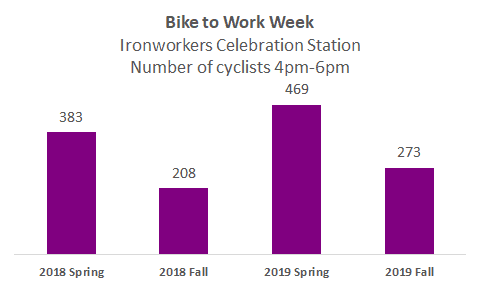 “Many people have more bikes than cars at their house,” said Jardine. “As an advocacy organization, we know people want to use them more but the infrastructure isn’t there. We go up into the mountains and ride on all these stunts but are afraid to ride on city streets.”
“Many people have more bikes than cars at their house,” said Jardine. “As an advocacy organization, we know people want to use them more but the infrastructure isn’t there. We go up into the mountains and ride on all these stunts but are afraid to ride on city streets.”
The community’s proximity to accessible outdoors attracts a certain kind of resident.
“We are an active community and that goes hand in hand with active transportation, people want to put effort in to get a bit of a workout,” he explained. “There are also people who are environmentally conscious and it’s a priority for them to be environmentally conscious with their transportation footprint.”
Both HUB and the District of North Vancouver are seeing trends of more cyclists on the road and especially more cyclists commuting.
Technological advances
One of the biggest changes to cycling is the rise of e-bikes. The motor-assisted bicycles are seeing technological advances and price decreases making the North Shore hills less daunting and more accessible.
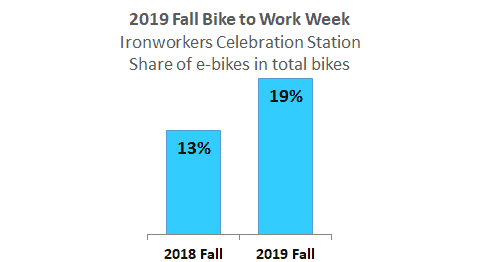 “We see from our count stations at Bike to Work Week the proportion of e-bikes is going up,” said Jardine. “We like to say it ‘flattens the shore.’ It’s no longer an ordeal to get home at the end of the day, it really opens the range of ages and abilities that can use the network.”
“We see from our count stations at Bike to Work Week the proportion of e-bikes is going up,” said Jardine. “We like to say it ‘flattens the shore.’ It’s no longer an ordeal to get home at the end of the day, it really opens the range of ages and abilities that can use the network.”
In the fall during an interview with Mayor Mike Little, he shared he has noticed a distinct increase in e-bikes and cycle commuters amongst District staff. So much so they have increased the number of District fleet vehicles as staff no longer use their own vehicles for work. Adding that the climbing numbers of all cyclists – especially e-cyclists – that makes him inclined to support projects like the 29th St. bike lane, as an essential east-west connection.
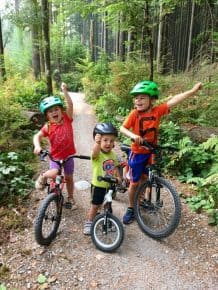 There are also trends to make cycling more family friendly with European-style cargo and longtail bikes becoming more common on North Van streets.
There are also trends to make cycling more family friendly with European-style cargo and longtail bikes becoming more common on North Van streets.
“People used to ask how they can bike or be car-free with kids,” said Jardine. “Of course some need to get their kids and gear to hockey practice in a mini-van but you also now see parents with two kids on the bike doing errands at Lynn Valley Mall.”
Infrastructure
With numerous projects on the books, HUB still continues to lobby for a more continuous network of cycling routes.
“Compared to Vancouver we just aren’t there yet,” said Jardine. “When we look at the profiles of riders we are very interested in the ‘Interested but concerned’ – that’s who we want to target with more infrastructure. What we would like to see are ‘class A’ facilities, almost always separated from traffic where the volume and speeds are too high. Almost always separated from pedestrians because cyclists can be a hazard, and a network of traffic calmed neighbourhood streets.”
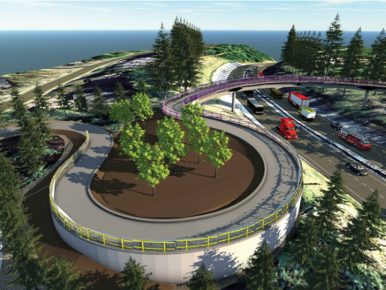
Casano-Loutet rendering. Supplied.
Vancouver has an extensive network of bikeways where there is a comfort for all ages and abilities to ride, said Jardine. North Vancouver has some obstacles to master with no continuous grid system and challenging geography but there are opportunities to improve.
According to the District’s website, most cycling infrastructure is completed during large and small road improvement projects.
“[The District looks] for opportunities to include new bike infrastructure where individual project budgets allow (the bike lanes on and around the new Keith Road and Montroyal bridges are examples of this approach). Because of the project-by-project approach we take to building bike lanes, new lanes don’t always connect to existing lanes, nor do they always lead to our most popular destinations. While this may be true in the short term, over time, these individual sections will begin to knit together into a complete system, as we continue including lanes in our infrastructure and road improvement projects,” says the District.
Jardine says HUB is happy to see what is happening in the Lower Lynn area and the forthcoming overpass linking Cedar Village and Loutet Park.
“It will be a game changer. This is infrastructure that allows for walking or riding your bike from one side of the highway to the other without interacting with traffic. It provides a whole new range of options to get around – to access CapU, the emerging town centre, the bridge.”
Challenges
Selling more cycling infrastructure and opportunities is always a bit of a challenge. From complaints about lack of car parking to weather, HUB is even hearing how poor residential planning and strata bylaws are making cycling more difficult.
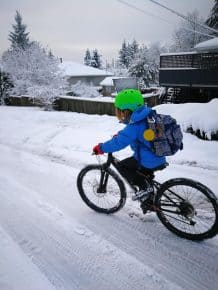 “It’s come to our attention that people want help around restrictions like moving bikes in elevators and creating more secure bike parking,” he said.
“It’s come to our attention that people want help around restrictions like moving bikes in elevators and creating more secure bike parking,” he said.
Where weather is concerned, Jardine points to other infrastructure that is only used part of the year – like beaches.
“Looking at Snowmageddon a couple of weeks ago – no one liked it,” he said. “Cars weren’t driving, parks and schools were closed, we don’t limit those infrastructure projects because they are shut down in poor weather. There are at least seven months where riding is ideal. When you add the comfortable lanes, the direct routes, the wayfinding signage maybe new technology, like e-bikes, you will see that riding in the rain isn’t as difficult as fighting through car traffic.
“Even if the bulk of ridership comes seven months of the year, that is seven months we see the benefits of better air quality and less congestion.”
What’s coming up
Two large forthcoming projects are on the City and District’s agendas to improve cycling infrastructure around Lynn Valley: the Casano-Loutet Bridge over the cut and a dedicated bike lane on Lynn Valley Road from Mountain Hwy to Kilmer. Both have start dates scheduled in 2020.
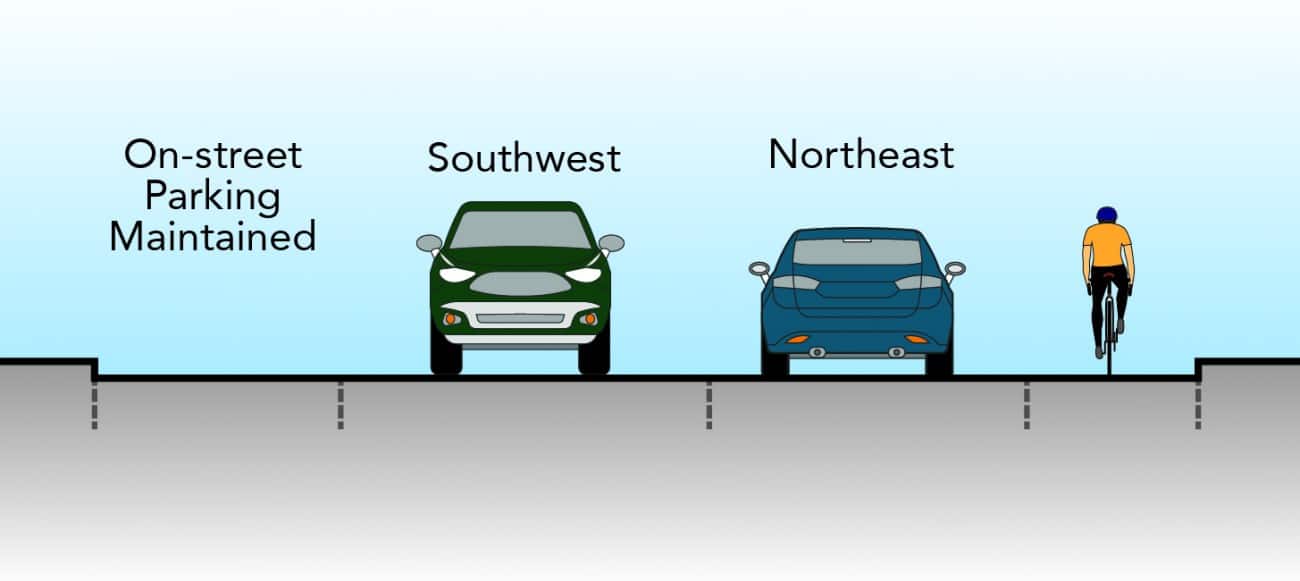
Lynn Valley bike lane
Looking for more?
There’s always something fun and exciting happening in Lynn Valley. Check out our Community Events Calendar or learn more about Local Activities, Mountain Biking or Hiking and Walking Trails.

